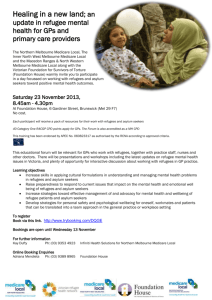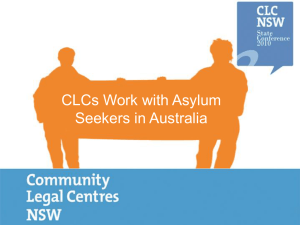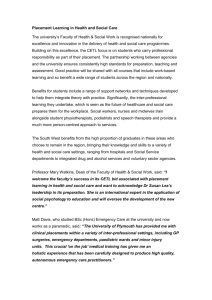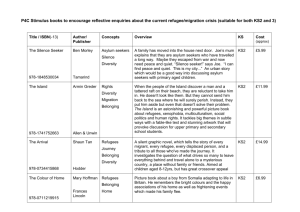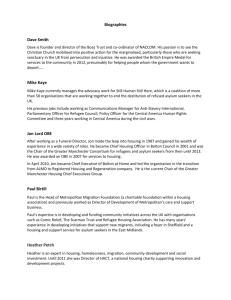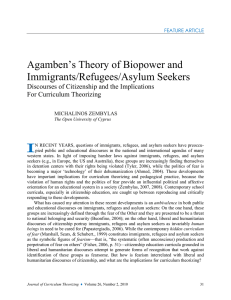N
advertisement
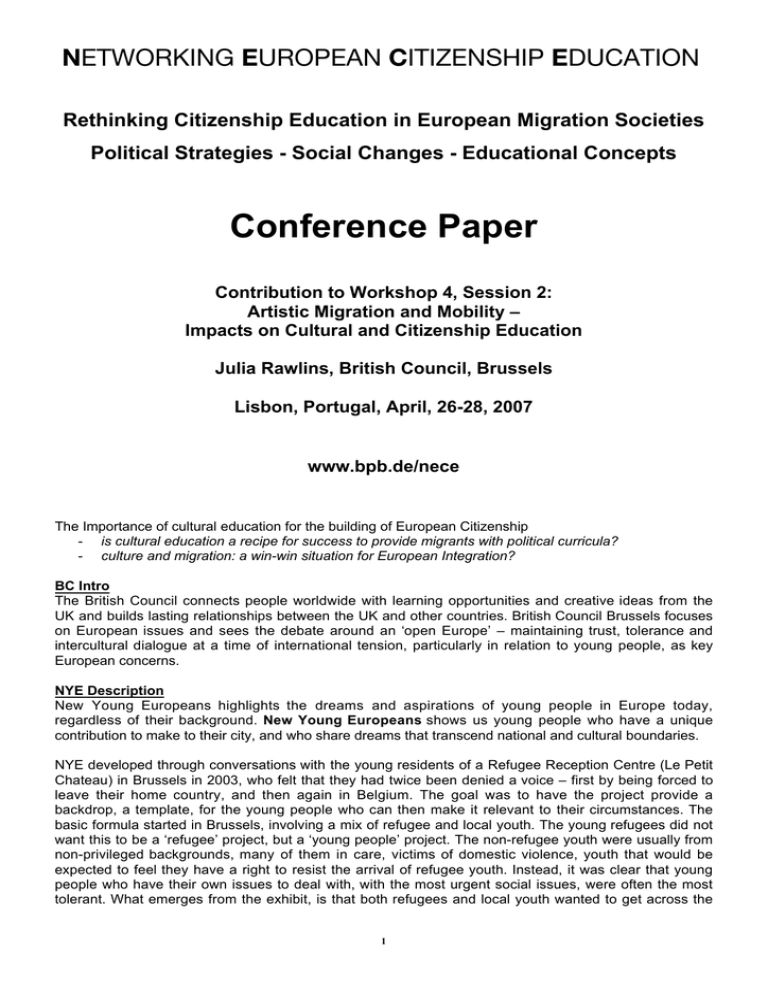
NETWORKING EUROPEAN CITIZENSHIP EDUCATION Rethinking Citizenship Education in European Migration Societies Political Strategies - Social Changes - Educational Concepts Conference Paper Contribution to Workshop 4, Session 2: Artistic Migration and Mobility – Impacts on Cultural and Citizenship Education Julia Rawlins, British Council, Brussels Lisbon, Portugal, April, 26-28, 2007 www.bpb.de/nece The Importance of cultural education for the building of European Citizenship - is cultural education a recipe for success to provide migrants with political curricula? - culture and migration: a win-win situation for European Integration? BC Intro The British Council connects people worldwide with learning opportunities and creative ideas from the UK and builds lasting relationships between the UK and other countries. British Council Brussels focuses on European issues and sees the debate around an ‘open Europe’ – maintaining trust, tolerance and intercultural dialogue at a time of international tension, particularly in relation to young people, as key European concerns. NYE Description New Young Europeans highlights the dreams and aspirations of young people in Europe today, regardless of their background. New Young Europeans shows us young people who have a unique contribution to make to their city, and who share dreams that transcend national and cultural boundaries. NYE developed through conversations with the young residents of a Refugee Reception Centre (Le Petit Chateau) in Brussels in 2003, who felt that they had twice been denied a voice – first by being forced to leave their home country, and then again in Belgium. The goal was to have the project provide a backdrop, a template, for the young people who can then make it relevant to their circumstances. The basic formula started in Brussels, involving a mix of refugee and local youth. The young refugees did not want this to be a ‘refugee’ project, but a ‘young people’ project. The non-refugee youth were usually from non-privileged backgrounds, many of them in care, victims of domestic violence, youth that would be expected to feel they have a right to resist the arrival of refugee youth. Instead, it was clear that young people who have their own issues to deal with, with the most urgent social issues, were often the most tolerant. What emerges from the exhibit, is that both refugees and local youth wanted to get across the 1 NETWORKING EUROPEAN CITIZENSHIP EDUCATION same message - to be seen as an individual with dreams and ambitions. The project involved young asylum seekers and refugees together with young Europeans with legal status in Brussels, Cardiff, Cologne, Helsinki, Edinburgh, London, Cork, Rome, Madrid and Krakow. By collaborating with partners in each of the cities visited, the project continues to shed light on the various issues of immigration of national importance but also of European importance. Most importantly, it offers a voice for teenagers/ adolescents who are so often ignored in this political debate. It offers them a creative voice through positive imaging both visually and through texts. This project crosses borders between countries, subjects and people and by bringing together a diverse range of people for an exhibition, animated discussion and performances, we are facilitating the sharing of new ideas and creativity all over Europe. New Young Europeans highlights the dreams and aspirations of young people in Europe today, regardless of their background. It is an artistic project, working with a writer and a photographer. It culminates in an exhibition which is professionally curated in a public space. It is created, designed and presented with the highest artistic standards. It is not a community project although the project will have worked with over 110 young people after its visit to Brussels in 2005. It engages deeply with a diversity of young people from different backgrounds. It forms lasting relationships, it has a broader impact on the general public visiting the exhibition, watching the film and reading the publication and is a platform for educational purposes. It reveals and contrasts the situation of teenagers in different European countries and non-European countries. All of the objectives are met through a creative medium. The importance of having professional interviews and photographs throughout the project has been one of the keys to its success. The project has received consistent positive feedback, both from the countries it has visited and the visitors attending the different exhibitions. The young people involved have talked of the project changing their lives, their perceptions of each other and their desire to be part of a social change. Politicians, such as Ken Livingston, the Mayor of London, spoke of the project as ‘a unique voice for those young people who deserved, more than anyone, to be heard'. The project gives the participants a sense of empowerment because they are in charge of what they say in their personal testimonies, and they also work with the photographer on how they want to appear in their portraits. The curator hangs the life-size portraits and texts in such a way that the visitor is confronted by the faces of the people whose voices they are reading thus giving the impression of conversing with the person. The opening of the exhibition is a crucial occasion for the young people to retain ownership of the project throughout its production and express themselves, be it by making a speech, performing a sketch or musically. At the opening event, the young participants introduce the politicians and VIPs and retain ownership of the opening ceremony. Aims/Messages 1. To promote a more balanced and honest awareness of the contributions young refugees arriving in Western Europe are making towards their host environments. 2. To challenge the current negativity, as recently proved by Mori polls and other national studies surrounding young asylum seekers and refugees. 3. To highlight the dreams and aspirations of all young Europeans, regardless of legal status, privileges and securities. 4. To show the integrity and courage of many of the young asylum seekers and refugees who are trying to reconstruct their lives without parents, siblings or known securities. 5. To show the intelligence and strength of the above in learning languages of their host community, adapting to their host environment and living as valued and caring members of a new European community. 6. To remind young European citizens, with legal status, that young asylum seekers are simply young 2 NETWORKING EUROPEAN CITIZENSHIP EDUCATION people who have been forced to leave their country. The photographs stress the individuality of each of these young people and also the courage of the young asylum seekers in surviving without the guidance and security of their families. 7. To demonstrate to Policy Makers and Politicians through the testimonies, that the young asylum seekers interviewed are politically aware, socially responsible and feel a sense of duty and debt to their host country. Those who receive their residency in Europe will use their right to vote and their views will be informed by their experiences. Impact 1) for participants: - recognition of their contribution - constantly scrutinized, having to justify being in this place, through NYE able to show experience of being a refugee is not all negative - significant for growing self-esteem 2) for partner organisation: - huge benefits from publicity and raised interest in their work - given them a new platform for their work and a gateway for new partnerships and funding - raised their profile to become nationally important, (e.g. Trinity Community Centre now representing London) 3) for BC - investment in a 3 year project about young people and in particular asylum seekers is a huge political statement. BC demonstrating values of respect, integrity, honesty and a holistic approach - sparking further initiatives between other organisations Keys to success/lessons learnt: - Public location and the partnerships - Creation of a cross-cultural European self-sustaining network - Project documentation – high quality and crucial for internal/external publicity - Main outputs: 9-minute film and 192-page book, also flyers, postcards and posters for different cities, website (online gallery) > positively received, esp. by teachers and Human Rights orgs - Ownership - Risk and political statement (e.g. choice of Le Petit Chateau as venue) underline importance of message - Creatively and individually-led, not bureaucratic - Holistic approach – honesty and integrity > impact - Responsive to each country and skills of each colleague Other British Council projects - The Migrant Integration Policy Index (Benchmarking the integration of migrants in Europe). This project is an exciting new tool to present the integration policies of the EU member states in a format which is concise, transparent and comparable. The Migrant Integration Policy Index presents scores for each Member State on over 100 indicators in key areas of integration policy such as political participation, anti-discrimination and access to employment. The Index will be published in October 2007. - What has the EU ever done for me? In December 2006, four UK students and their teachers, winners of the ‘What has the EU done for me’ Competition came to Brussels to see the summit. They shared compelling views on the EU, quizzing MEPs, Commissioners and the man in charge of running the summit. Turkey; Cyprus; the fight against terrorism; concerns on EU federalism; the environment; education; why young people don’t care about Europe… the winners touched on some key issues for the UK, ensuring that views from UK’s youth reached the highest level. They also walked away with a much more informed view of just what goes on in that Brussels place. 3 NETWORKING EUROPEAN CITIZENSHIP EDUCATION - Inclusion and Diversity in Education The aim of this project is to promote social cohesion and raise educational standards in culturally inclusive schools by providing the opportunity for developing shared best practice guidelines for policymakers, school leaders, young leaders, staff, families and the community. We will build lasting networks which focus on the common challenges presented by immigration and cultural diversity to school education in participating countries. 4
